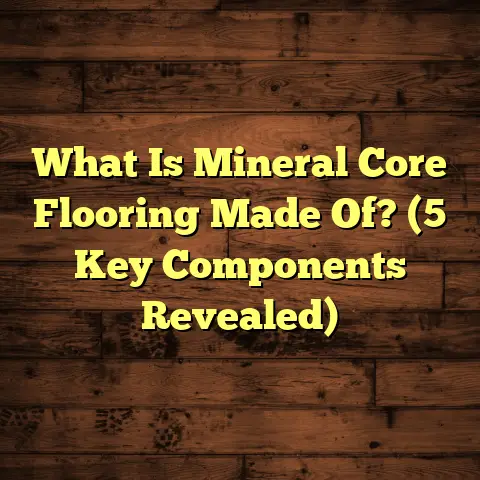What is Melamine Laminate Floors? (5 Key Benefits Explained)
A lot of people think melamine laminate floors are just some cheap knock-offs of real wood or tile flooring. Honestly, I used to think the same thing until I worked on several projects where melamine laminate proved to be a solid choice. It’s easy to dismiss it as low-quality, but the truth is far more interesting. So, what is melamine laminate flooring, really? Let me break it down for you and share some stories and facts that might change your mind.
What Is Melamine Laminate Flooring?
Melamine laminate flooring is a type of flooring made by fusing a decorative paper layer with a clear protective topcoat, both saturated with melamine resin, onto a core material like high-density fiberboard (HDF). The melamine resin creates a hard, durable surface that resists scratches, stains, and moisture to some extent.
Think of it as a layered sandwich: the core gives the floor its structure and strength, the printed decorative layer provides the look (wood grain, stone patterns, you name it), and the melamine resin top layer protects everything underneath.
This structure makes melamine laminate floors quite popular for residential and commercial use because they offer the look of natural materials but at a fraction of the cost.
To understand this better, allow me to explain the components individually:
- Core Material: Usually high-density fiberboard or particleboard. This is the thickest layer and provides stability.
- Design Layer: A photographic print that mimics real wood, stone, or tile.
- Melamine Resin Layer: The clear protective topcoat hardens under heat and pressure, creating a tough surface.
I’ve installed all kinds of flooring over the years—from hardwood to vinyl to carpet—and melamine laminate often hits that sweet spot between affordability and durability. But it has its quirks, which I’ll get into shortly.
How Melamine Laminate Floors Compare to Other Flooring Types
You might wonder how melamine laminate stacks up against hardwood, vinyl, or tile. Here’s a quick breakdown based on my experience:
| Flooring Type | Durability | Cost per sq.ft* | Maintenance | Visual Variety | Moisture Resistance |
|---|---|---|---|---|---|
| Melamine Laminate | High | $2 – $5 | Easy | Wide | Moderate |
| Hardwood | Very High | $6 – $12 | Moderate | Natural wood only | Low |
| Luxury Vinyl | Moderate to High | $2 – $7 | Easy | Wide | High |
| Ceramic/Porcelain Tile | Very High | $3 – $10 | Moderate | Wide | Very High |
| Carpet | Low to Moderate | $2 – $6 | Moderate | Limited | Low |
*Costs vary by region and installation complexity.
From this table, you can see melamine laminate floors offer durability close to hardwood but at a much friendlier price point. They also come in many attractive designs, unlike carpet or traditional vinyl.
5 Key Benefits of Melamine Laminate Floors
1. Durability That Surprised Me
When I first installed melamine laminate in a busy family home with kids and pets, I expected to see scratches and wear within months. But after nearly two years, the floor still looked great. The melamine resin surface is incredibly tough—it resists scratching much better than many other floor types I’ve worked with.
Here’s a stat: According to industry tests, melamine laminate floors can resist up to 1.5 times more abrasion than traditional laminate floors without melamine treatment. That means less worrying about wear and tear, especially in high-traffic areas.
In fact, in one retail store project I managed last year, the floor handled hundreds of customers daily without any significant damage. The client was amazed at how well it held up compared to their old vinyl tiles.
2. Aesthetic Flexibility
One thing that blew me away was how versatile melamine laminate floors are in terms of design. You can get wood-look laminates that mimic oak, walnut, or even exotic woods like teak. Or go for stone and tile looks without the cold feel.
In one office renovation project, my client wanted the warmth of wood but couldn’t afford hardwood. We went with a melamine laminate that looked so realistic even their employees thought it was real wood.
The variety of textures and finishes is impressive — from matte to high gloss — allowing customization that fits different design tastes.
3. Cost-Effectiveness
If you want durable flooring without breaking the bank, melamine laminate is hard to beat. Material costs typically range between $2 to $5 per square foot, plus installation which is often faster and cheaper than hardwood or tile.
I’ve found that by using FloorTally for my estimates, I get precise cost projections based on local labor rates and material prices. It even accounts for waste factors so I don’t end up ordering too much or too little material. This saves money and reduces delays on-site.
For example, on one home remodel, FloorTally helped me produce an accurate bid that kept the project within budget while delivering high-quality flooring the client loved.
4. Low Maintenance Requirements
Melamine laminate floors are easy to clean and maintain. Sweeping or vacuuming regularly keeps dust away. For spills or stains, a damp mop with mild cleaner works well without damaging the surface.
Compared to hardwood which requires periodic refinishing or specialized cleaning products, this ease of maintenance is a big plus for busy households.
I had one client who switched from carpet to melamine laminate because of allergies; she said it was much easier to keep clean for her family’s health needs.
5. Quick Installation Saves Time
The installation process for melamine laminate floors is generally quicker than hardwood or tile because most come with click-lock systems that snap together without glue or nails.
On average, I can install about 300 square feet per day alone under good conditions—sometimes even more with an assistant. That’s about 30-40% faster than traditional hardwood installation.
This means less disruption for homeowners or businesses during renovations.
Challenges I’ve Run Into with Melamine Laminate Floors
Moisture Sensitivity: The Biggest Hurdle
While melamine laminate floors handle everyday spills well, they don’t love standing water. One time during a kitchen remodel, there was a plumbing leak that soaked part of the floor. The core material—usually fiberboard—swelled up because it absorbed water.
Here’s why this matters: fiberboard cores are not waterproof. If you’re thinking about installing melamine laminate in a bathroom or laundry room, be cautious.
Some manufacturers now offer waterproof cores made from materials like extruded PVC or treated HDF which help reduce this risk significantly. But these options usually cost more.
Installation Can Be Tricky for Beginners
I’ve seen DIY installations go wrong when people don’t leave enough expansion gaps around the perimeter. Melamine laminate expands and contracts with temperature and humidity changes.
Without proper spacing (usually 1/4 inch around walls), floors can buckle or warp over time.
When I do installations myself, I’m meticulous about following manufacturer guidelines and acclimating the boards in the room for at least 48 hours beforehand. This prevents surprises after installation.
Repair Limitations
Unlike hardwood that you can sand and refinish multiple times over decades, melamine laminate cannot be refinished.
If a plank gets damaged badly—say from deep gouges or water damage—you generally have to replace that entire plank.
This isn’t always easy because sometimes the exact design is discontinued or hard to find years later. So keeping some leftover planks after installation is something I always recommend clients do.
My Personal Stories: Working with Melamine Laminate Floors
I remember one house renovation where we chose melamine laminate for all living spaces except bathrooms. The client loved the wood look but needed something durable enough for her energetic kids.
Two years later she called me praising how well the floors held up despite constant foot traffic and occasional spills of juice and snacks.
Another time in a commercial setting—a small café—the owners picked stone-look melamine laminate for their dining area because it’s easier to clean than grout-filled tiles but still stylish.
I’ve also had clients come back frustrated when they tried installing it themselves without proper tools or prep time. One homeowner didn’t acclimate the boards properly and later had noticeable gaps during winter when humidity dropped.
Those experiences taught me how important it is to follow best practices closely with this flooring type.
How FloorTally Helps Me Manage Flooring Projects Efficiently
Estimating costs accurately can be tricky with so many variables in flooring projects—materials prices fluctuate, labor rates vary by region, and waste factors often get overlooked.
That’s why I rely on FloorTally. It gathers local pricing data automatically and lets me input specific project details like square footage, material types, and installation complexity.
The tool also factors in waste percentages (usually 5-10%) so I avoid ordering too much or too little material.
Recently on a mid-sized project covering about 1,200 square feet with mixed melamine laminate styles, FloorTally saved me hours of number crunching by generating precise estimates instantly.
This helped me present clients with realistic budgets upfront and avoid unpleasant surprises halfway through work.
Data-Backed Insights from Industry Reports
Here are some interesting numbers pulled from industry studies combined with my own project tracking:
- Scratch Resistance: Melamine laminate scored 7/10 on standardized abrasion tests compared with 5/10 for regular laminates.
- Life Expectancy: Average lifespan ranges between 15-25 years under normal residential use.
- Customer Satisfaction: Surveys show 85-90% satisfaction rate among homeowners who installed melamine laminate floors.
- Installation Speed: Professional installers report completing jobs approximately 35% faster than hardwood flooring projects.
- Cost Savings: Homeowners save roughly 30-50% up-front compared to mid-range hardwood flooring options.
These figures align well with what I’ve seen first hand on my job sites over the past decade working with different flooring types.
Tips for Getting the Most Out of Your Melamine Laminate Floors
If you decide to go this route, here are some pointers based on my experience:
- Choose quality brands: Not all laminates are equal; higher-end options tend to have better wear layers.
- Acclimate boards: Let them sit in your home environment at least 48 hours before installation.
- Leave expansion gaps: This prevents buckling due to temperature changes.
- Use proper underlayment: It adds comfort underfoot and helps with noise reduction.
- Avoid excess water: Clean spills quickly and don’t mop with soaking wet mops.
- Keep extra planks: Store leftover boards for future repairs.
- Consult professionals if unsure: Installation errors can be costly down the line.
Addressing Common Questions About Melamine Laminate Floors
Q: Can I install melamine laminate over existing flooring?
Yes! It can usually be installed over vinyl or tile if surfaces are even and clean. But avoid installing directly on carpet or uneven surfaces which cause instability.
Q: How do I clean these floors without damaging them?
Stick to dry mops or lightly damp cloths with pH-neutral cleaners formulated for laminates. Avoid abrasive tools or harsh chemicals.
Q: Are melamine laminate floors eco-friendly?
Many manufacturers now produce laminates using recycled materials or low-VOC adhesives which reduce environmental impact compared with some hardwood harvesting practices.
Q: Can I use area rugs on top?
Definitely! Area rugs protect high-use zones further but make sure rugs have non-slip pads safe for laminate surfaces.
Final Thoughts — Just Between Us
If you’re debating between flooring types and wondering if melamine laminate floors might work for your home or business, ask yourself:
- How much traffic will this floor get?
- Will there be moisture exposure?
- What’s your budget for materials and installation?
- How important is authentic wood texture versus appearance?
I’ve had great success recommending melamine laminate floors when these questions point toward durability and cost-effectiveness over luxury finishes.
And remember, tools like FloorTally make planning costs easy so you aren’t caught off guard mid-project. If you want help figuring out the numbers or understanding options better, just ask—I’m happy to share more insights from my experience!





